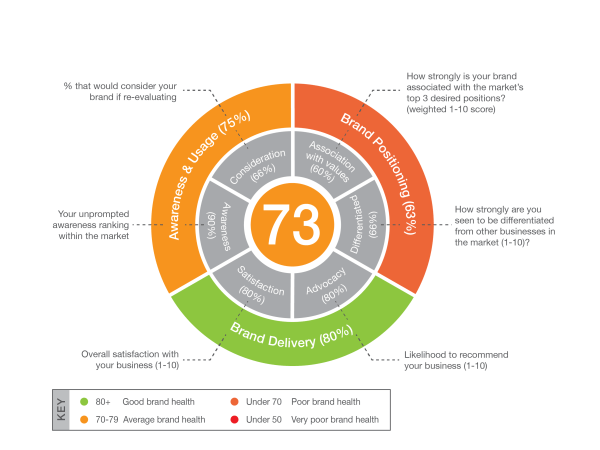How to measure brand health and conduct a brand health audit
The role of a brand in developing a loyal and profitable customer base and providing a strong differentiation from competitors, has never been more important. The ease with which companies can now communicate globally, multiplies the number of effective competitors in many sectors. If brands fail to distinguish themselves in this explosion of competition, they will be seen as interchangeable, leaving price as the key discriminating factor. There may be a ‘brand’ name, but without a clear, relevant and differentiated brand positioning, this is simply a label to write on the box.
The brands owned by the Forbes 500 organisations are estimated to account for 30% of their combined balance sheets. Furthermore, the top 100 brands in the Millward Brown Brandz list of the Most Valuable Brands show an increase in value of 14% in the past year alone, and 126% over the 10 years of the study.
Brands clearly have a value, however when we ask business people how important the brand is to them in their business decisions, they routinely attach an insignificant weight of around 5% to its importance. Business buyers claim to be rational in their decisions and driven by price, availability or reliability of a product or service.
We think otherwise. In-depth statistical analysis of market research data and observation tells us that emotions and intantible attributes of a brand can play a very important role. They can a decisive positive or negative impact on which brands win, customer satisfaction, advocacy and retention. Buyers of business products and services switch suppliers relatively infrequently and sometimes stay loyal for years – despite there being cheaper and possibly better products available to them. The reputation of a company (its brand by any other name) is so important that it could account for 50% rather than 5% of the buying decision.
The risk manager who returns to the account manager who puts his mind at rest, the tradesman who enjoys a free coffee or newspaper at the builders’ merchant, or the IT manager who insists on a single printer manufacturer are certainly influenced by the brand, as well as the functional features of the products they choose.
The crux of the issue here is ‘what is the brand?’ and ‘what makes it strong’?
There are three main components to brand health tracking – we describe these as the “brand health wheel“. These are the essential metrics that any brand health audit should take into consideration:
- Awareness and usage – if potential customers have no awareness of your brand, they cannot consider it. Measuring levels of awareness and use is a critical component of brand health.
- Brand positioning – your brand has to stand for something and that something should be what customers and potential customers want.
- Brand delivery – the brand must live up to its promise.
These three important components of the brand health scorecard can be further broken down into other metrics. These measurements lead to an overall brand strength score. This is illustrated in the diagram below.
The Brand Health Wheel / Brand Health Scorecard

Brand awareness and usage – The foundations of a brand health audit
For a brand to do its job, it stands to reason that people must know about it. But that’s not enough – b2b brand owners must consider their target audiences in the widest sense. These include but are not limited to:
- Specifiers
- Influencers
- Decision makers
- Approvers
- Users
- Order placers
B2B purchase decisions, in particular, require rather more justification to other stakeholders, than a personal consumer decision. It is far less likely that a high value purchase, or ongoing contract will be awarded to a business that a key decision maker has never heard of.
More directly related to the business bottom line, is the percentage of the target audience who use a brand. Strong brand penetration, as well as a high share of wallet within a category, are key to building and maintaining a profitable customer base. Retaining, and building spend with a given customer is always less costly than spreading sales thinly amongst an ever changing audience.
Brand positioning
The awareness that a brand has amongst its target audiences is clearly critically important. If somebody doesn’t know of a brand, it will have no position in their mind and quite probably will not be included in a consideration set. Brands can very quickly lose billions of dollars off the value of their brands in a short space of time. More often than not, this is caused not by a decline in awareness, but in the positioning within customers’ minds.
The positioning of a brand is inextricably linked to brand benefits, perceptions and associations such as:
- Relevant to the needs of the individual and their business
- Clear and distinct from the associations with competitor brands
- Credible and consistent across all touchpoints and experiences of the brand
Relevance to a potential customer is at its most basic ‘do you supply the product type I’m looking for?’. It’s no good being a leading brand in cameras, if no-one knows you make office printers. A brand that has a level of awareness linked to a positioning that is relevant to the target audience is one step closer to being considered in a b2b purchase decision. At its most compelling, a relevant brand so strongly connects with its audience, their lives and needs, that nothing else will do. Ask a Manchester United fan to fly with an airline whose brand is on the front of arch rival Manchester City’s shirts and watch them squirm!
Distinctiveness is the key to differentiation and can take many forms. A product can be distinguished by its functional features or benefits, whilst a brand needs to feel different. Only then can there be loyalty beyond reason. A strong brand gives reassurance and trust that the company’s money has been well spent, and that you, the decision maker, are a smart and competent businessman. Beyond this, a brand may offer emotional benefits of inspiration, fun or belonging.
With an understanding of what the ‘ideal’ brand in a market will represent to its target audience, a brand must then be inextricably and uniquely connected to that positioning. Which brings us to the final part of the Brand Health Scorecard…
Delivery of the Brand Promise
I use the word ‘delivery’ rather than ‘communication’ because a brand’s beauty is in the eye of the beholder. This is not about a business’s advertising messages, or even its marketing output in a wider sense. A brand’s position in the hearts and minds of its b2b target audience is a product of all messages and impressions received from all sources.
Though we are principally addressing business decision making in this article, it is as human beings that we gather and process experiences to create our view of a brand. If delivery of the brand promise comes down to one word, it is ‘consistency’.
- Consistency means that your brand’s positioning has the chance to transmit loud and clear through the noise of business life to mean something, rather than nothing, to your b2b audience
- Consistency of message, customer knowledge and experience lends credibility and ownership of your brand positioning
- Consistency means that every single experience of a brand should fit together as part of the same entity:
- from the first time a brand name passes your eyes sponsoring a local golf event
- through advertising, and every kind of marketing communication, including a brand’s visual identity
- the way your phone call or email enquiry is answered when you get in touch
- the enquiry, proposal and business development process
- the service design and set up phase
- the quality and attributes of the product and service itself (though this may in rational terms differ little from the competition)
- your experience as a customer and the way you are dealt with by all people from all departments and functions of the business
- the values by which a business is seen to operate
- and, most difficult of all to manage; comments, reviews and news stories from customers, competitors or press – our multi-media world makes this an ever growing and changing challenge
Early in this article I suggested that the greater role played by personal relationships in many b2b business interactions may reduce the importance of the brand. However, when a brand is consistently delivered across all touchpoints, these relationships are powerful tools in embodying the values of the brand itself, and strengthening emotional relationships with the brand. Will you really turn down a proposal from an account manager you trust and get on with, if there is no rational difference from a competitive offering?
In short, the brand is something that your business IS and not what it wants, or claims to be. Building a strong brand is the biggest single determinant of long term business success. As b2b marketers join their b2c colleagues in building strong and powerful brands that are relevant, unique and consistent across every touchpoint, who wants to be the ‘product’ left behind?
Readers of this white paper also viewed:
Market Sizing: Is There A Market Size Formula? Market Segmentation in B2B Markets B2B Branding: Business-to-Business Branding White Paper


